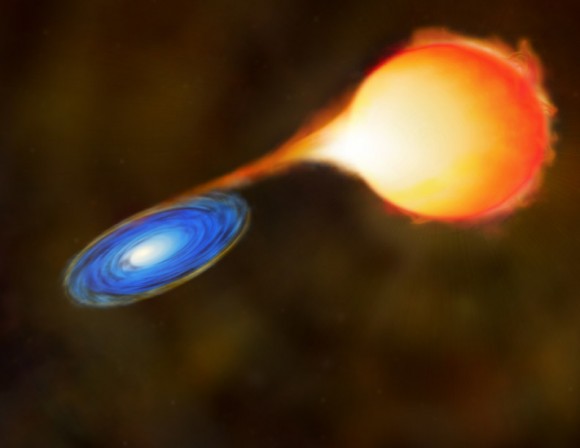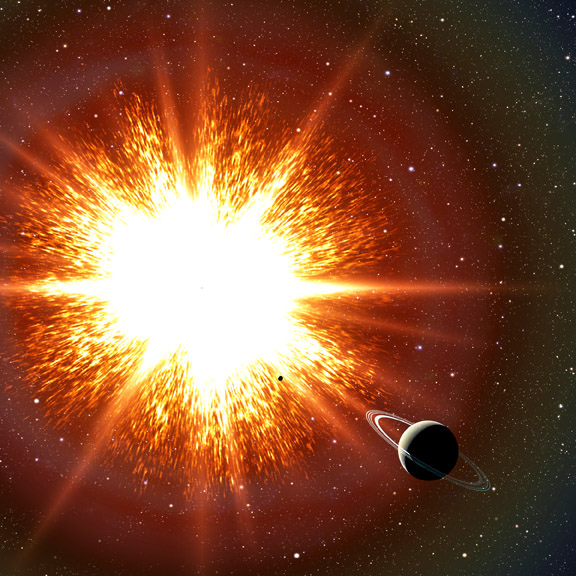[/caption]Let’s face it, cosmologists catch a lot of flack. It’s easy to see why. These are people who routinely publish papers that claim to ever more finely constrain the size of the visible Universe, the rate of its breakneck expansion, and the distance to galaxies that lie closer and closer to the edges of both time and space. Many skeptics scoff at scientists who seem to draw such grand conclusions without being able to directly measure the unbelievable cosmic distances involved. Well, it turns out cosmologists are a creative bunch. Enter our star (ha, ha): the Type 1a Supernova. These stellar fireballs are one of the main tools astronomers use in order to make such fantastic discoveries about our Universe. But how exactly do they do it?
First, let’s talk physics. Type 1a supernovae result from a mismatched marriage gone wrong. When a red giant and white dwarf (or, less commonly, two white dwarfs) become trapped in a gravitational standoff, the denser dwarf star begins to accrete material from its bloated companion. Eventually the white dwarf reaches a critical mass (about 1.4 times that of our own Sun) and the natural pressure exerted by its core can no longer support its weight. A runaway nuclear reaction occurs, resulting in a cataclysmic explosion so large, it can be seen billions of light years away. Since type 1a supernovae always result from the collapse of a white dwarf, and since the white dwarf always becomes unstable at exactly the same mass, astronomers can easily work out the precise luminosity of such an event. And they have. This is great news, because it means that type 1a supernovae can be used as so-called standard candles with which to probe distances in the Universe. After all, if you know how bright something is and you know how bright it appears from where you are, you can easily figure out how far away it must be.

Now here’s where cosmology comes in. Photons naturally lose energy as they travel across the expanding Universe, so the light astronomers observe coming from type 1a supernovae will always be redshifted. The magnitude of that redshift depends on the amount of dark energy that is causing the Universe to expand. It also means that the apparent brightness of a supernova (that is, how bright it looks from Earth) can be monitored to determine how quickly it is receding from our line of view. Observations of the night sky will always be a function of a specific cosmology; but because their distances can be so easily calculated, type 1a supernovae actually allow astronomers to draw a physical map of the expansion of the Universe.
Spotting a type 1a supernova in its early, explosive throes is a rare event; after all, the Universe is a pretty big place. But when it does happen, it offers observers an unparalleled opportunity to dissect the chaos that leads to such a massive explosion. Sometimes astronomers are even lucky enough to catch one right in our cosmic backyard, a feat that occurred last August when Caltech’s Palomar Transit Factory (PTF) detected a type 1a supernova in M101, a galaxy just 25 million light years away. By the way, it isn’t just professionals that got to have all the fun! Amateur and career astronomers alike were able to use this supernova (the romantically named PTF11kly) to probe the inner workings of these precious standard candles. Want to learn more about how you can get in on the action the next time around? Check out UT’s podcast, Getting Started in Amateur Astronomy for more information.


I am a bit confused by the statement that “Photons naturally lose energy as they travel across the expanding Universe”. My understanding, based on the most superficial knowledge of relativity, is that the red shift is caused not by distance but by the fact that the distance between us and the distant object is increasing. Of course, since more distant objects are in fact receding at a proportional rate. There is also a fair amount of cosmic dust, but it is my understanding that this dims and scatters light, but doesn’t redshift it. Is that correct?
Yes, this is correct. Redshifting occurs due to a relative difference in motion, but the photon does lose energy when its frequency decreases.
Redshift happens for many reasons:
– Red- and blueshifts from classical and relativistic doppler effects are coupled to relative motions.
– Gravitational red- and blueshifts happens when photons ascend or descend a gravitational potential.
– Cosmological redshifts are caused by spacetime cosmological expansion, stretching the wavelength of the photons. (And analogously a blueshift would be seen if the universe were collapsing.)
Increasing the wavelength λ means decreasing the frequency ν = 1/λ. Which indeed means decreasing the photon energy E = hν.
The original text is a shorthand for the latter effect.
Also, it may be interesting to note that this energy loss is permitted by relativity, since there is no global energy measure in general relativity. It is when you make cosmological models that includes general relativity that you can, arguably, recover some sense of “energy of the universe”.*
—————-
* Which, most argue, translates to average zero energy density, in concordance with the globally flat space that standard cosmology gives. In which case you don’t really lose any energy in the end, and can live happily with a thermodynamically closed universe after all.
And we know that thanks to those standard candles illuminating [sic!] how the expansion accelerates over time and closing the case!
One way of thinking about this is to think of any region of the universe, say a box, as a resonance cavity with photons. For every photon of a given wavelength that leaves the box on average one will enter. Hence each wavelength is a standing wave in this cavity in some discrete approximation. The expansion of the universe is like expanding the box, which stretches or increases the wavelength. The energy of these photons in the box is E = ?V, for ? the energy density and V the volume. The energy is then E = hc/?, for ? the wavelength, h the Planck unit of action and c = speed of light. The volume scales as V ~ 1/?^3, and so the density scales as 1/?^4. This is a basic rule for radiation dominated cosmology. So these photons are losing energy. Where does the energy go? It goes into the gravity field or the “geometrodynamic field” of space.
LC
I made a slight error in my post that I corrected. I stated the volume scales as V ~ 1/?^3, when of course it is V ~ ?^3. The de Broglie form of the energy E = hc/?, means the density must scale as ? ~ 1/?^4 for E = ?V.
LC
nice seeing my artwork coupled to a great article! Keep shining V -DA
” A runaway chemical reaction occurs”
I think you mean nuclear reaction. There is no chemistry going on at those temperatures.
You are absolutely right. Thanks for the correction!
Regarding the Physics ( paragraph II of this excellent piece ):
It is remarkable that these precisely lined ( or numbered ) laws exist, which define boundaries and reveal limits ( like that given of surface stellar-matter accumulations, and related core stability levels, perimeters of critical mass, quantifiable detonation output, which itself is governed by exact calculable terms[?], else what value as a “standard candle” ), photon motion in space, its energy readings through time, and so on…
I, a scientific nobody, would posit that the uncertainties about those great governing laws on at the extreme macro and micro-scale ends of Science – are not uncertain at all: Could it just be, it is only because physical man is inescapably confined to his material plane of reality – the 4-Dimension Universe of our birth.
I have suspected for some while, that man has approached, or come within “sight” of the very limits of what he can know and understand, if not discover ( quantum properties, the “Dark” mysteries? ), before it elusively, and mysteriously phases into another plane beyond his comprehensible understanding, or interfaces with a different existence ( more like coming from, than going into ) – recedes away from his capacity to “see”, disappearing over an unreachable horizon of what he can learn.
Yet, what lies behind this curtain separation, if you will, is intimately related to our space-time – again, like the shadow to a great marble pillar, a shifting, changing, fading, waxing-waning shadow: One is superior, the other inferior; one is more “solid” – real – than the other; one is not effected by time ( in a sense, outside of “shadow”-time ), the other is integral to it, or locked-in.
That whole Universe-regulating, governing-law matrix, which operates in space, regulates time, and works in matter – the local planetary application of which led one representative man to make one small step ( a very successful one ) in one giant leap for mankind – we are confidently told by the cosmologists, came from the sudden appearance of the great infinite-propertied “Singularity”.
These are the same brilliant, creative minds, I presume, who conceived of the Vedic concept of multiverses, alternate universes “clustered together like foam” on the surface of a “Causal Ocean”, bubbles riding on, and inflating out of bubbles…??
A mystery of mysteries …
Where would Science be if not for that Law Matrix, or color-radiant System? Hopelessly lost in shifting shadows of gray uncertainties, unborn into the prismatic light of clear Scientific discovery, never to see its sharp-defined spectrum of beauty!
Geez, how can you guys talk about photon energies with a cutie like that writing neat little explanations of cosmological determination and making vegetarian meals to boot?